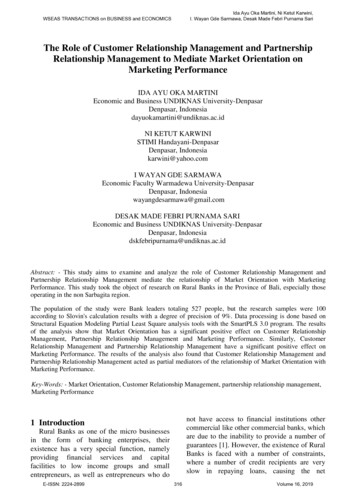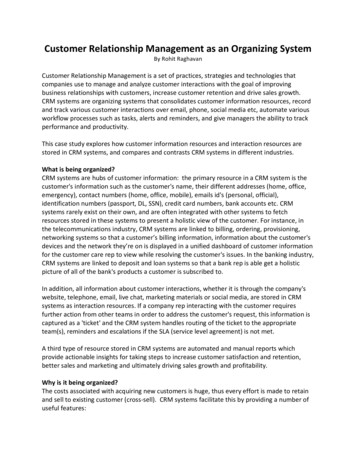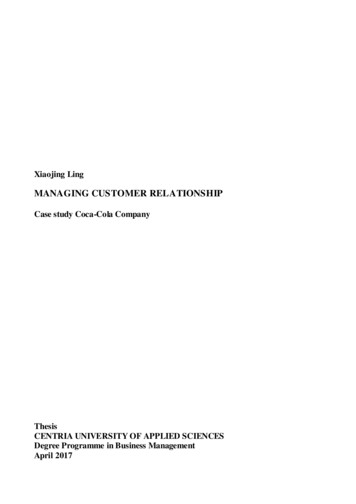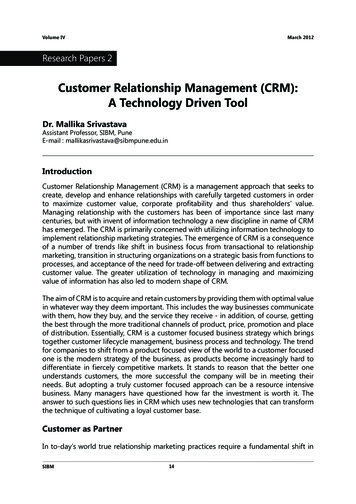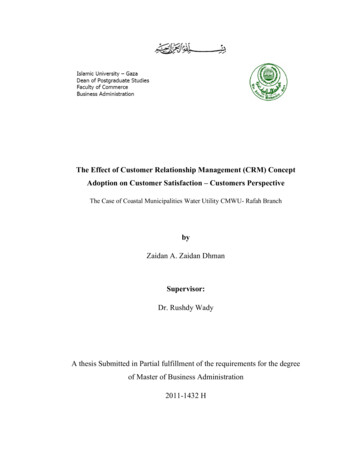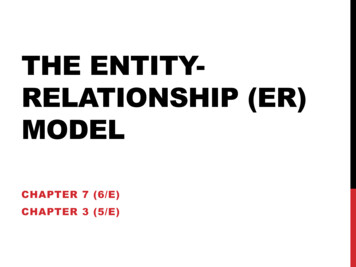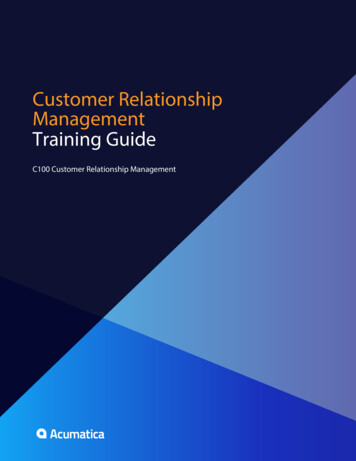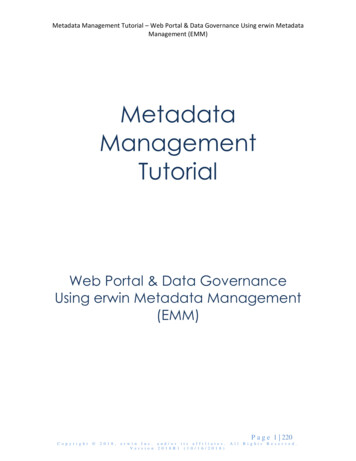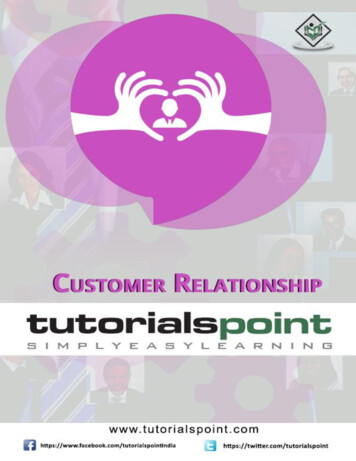
Transcription
Customer Relationship ManagementAbout the TutorialCustomer Relationship Management (CRM) in a very broad way can be defined as the effortsmade towards creating, developing, and maintaining a healthy and long-lasting relationshipwith the customers using technology. This tutorial is an introductory guide to CRM thattouches upon various topics such as understanding 21st century customers and managingthem, building value for them, CRM software, and future trends in CRM.AudienceThis tutorial is prepared for beginners to help them understand the basics of CustomerRelationship Management. It will be quite a useful learning material for all those readers whowant to make a career in management and professionals who interact with customers as theface of their companies.PrerequisitesWe assume the reader has a basic knowledge of business administration, marketing concepts,basic database concepts, and software. Analytical thinking, strategic thinking, and goodcommunication skills are a plus.Disclaimer & Copyright Copyright 2014 by Tutorials Point (I) Pvt. Ltd.All the content and graphics published in this e-book are the property of Tutorials Point (I)Pvt. Ltd. The user of this e-book is prohibited to reuse, retain, copy, distribute or republishany contents or a part of contents of this e-book in any manner without written consent ofthe publisher.We strive to update the contents of our website and tutorials as timely and as precisely aspossible, however, the contents may contain inaccuracies or errors. Tutorials Point (I) Pvt.Ltd. provides no guarantee regarding the accuracy, timeliness or completeness of our websiteor its contents including this tutorial. If you discover any errors on our website or in thistutorial, please notify us at contact@tutorialspoint.com.i
Customer Relationship ManagementTable of ContentsAbout the Tutorial . iAudience . iPrerequisites . iDisclaimer & Copyright . iTable of Contents . iiPART 1 – CRM BASICS . 11.Introduction to CRM . 2What is CRM? .2Ingredients of CRM .3Objectives of CRM .4History of CRM.52.Types of CRM . 6Strategic CRM .6Operational CRM .7Analytical CRM.8Collaborative CRM .9CRM Software Buying Considerations .93.Customer Relationships . 11What is Relationship? .11Why a Business Wants Relationship with its Customers? .13Relationship Management Theories .13PART 2 – MANAGING CUSTOMERS . 154.21st Century Customers . 16Who is .16an Empowered Customer? .16Customer Life Cycle .17Consumer vs. Customer.18Types of Customers .18Customer Orientation .19Customer Management Strategies .19Customer Acquisition .205.Building Value for Customers . 21What is Value? .21Customer’s Sacrifices .21Sources of Value .22ii
Customer Relationship Management6.Managing the Customers . 24The New Customers .24Strategies for Customer Acquisition .24Phases of Customer Development .25Strategies for Customer Retention .26Strategies for Terminating Customer Relationship .27PART 3 – CRM IMPLEMENTATION . 297.Implementing CRM Projects. 30Developing CRM Strategy .30Building CRM Project Foundation .31Identifying Business Processes .32Specifying Requirements .32Creating Proposals .34Selecting Partner .34Implementing the CRM Project .34Performance Evaluation .358.Customer Related Databases . 36What is Customer-Related Database? .36Developing and Maintaining Customer-Related Database .37Types of Customer Data .37Database and Hardware for CRM .38Data Attributes .38Data Warehousing (DW) .39Data Marts .39Data Access and Interrogation .40Position of CRM with Respect to Database .41PART 4 – CRM AND AUTOMATION . 429.Sales Force Automation (SFA) . 43SFA Solution Providers.43SFA Hardware and Infrastructure .44SFA Allied Services .44Functionalities of SFA Software .44Benefits of Sales Force Automation .4610. Marketing Automation . 47Marketing Automation Software Applications .47Benefits of Marketing Automation .4811. Service Automation . 50Benefits of Service Automation .51Service Automation Software Applications .51iii
Customer Relationship Management12. Emerging Trends in CRM . 53What is ECRM? .53Future CRM Trends .54iv
Customer Relationship ManagementPart 1 – CRM Basics5
1. INTRODUCTION TO CRMCustomer Relationship Management“Successful CRM is about competing in the relationship dimension. Not as an alternativeto having a competitive product or reasonable price, but as a differentiator. If yourcompetitors are doing the same thing as you are (as they generally are), product andprice won’t give you a long-term, sustainable competitive advantage. But if you can getan edge based on how customers feel about your company, it’s a much stickier–sustainable–relationship over the long haul.”– Bob Thompson, CustomerThink CorporationBusiness people started using the term Customer Relationship Management (CRM) since theearly 1990s when the concept of business started to change from being transactional torelational. CRM directly contributes towards customer benefits and the growth of businesses.Information Technology plays a very critical role in identifying, acquiring, and retaining thecustomers, and thereby managing a healthy relationship with them.Here in this chapter, we will discuss the very basics of CRM.What is CRM?There can be multiple definitions of CRM from different perspectives: From the viewpoint of the Management, CRM can be defined as an organized approachof developing, managing, and maintaining a profitable relationship with customers. By equating the term with technology, the IT organizations define CRM as a softwarethat assists marketing, merchandising, selling, and smooth service operations of abusiness. As per Franics Buttle, World’s first professor of CRM, it is the core business strategythat integrates internal processes and functions, and external networks, to create anddeliver value to a target customer at profit. It is grounded on high quality customerdata and information technology.The primary goal of CRM is to increase customer loyalty and in turn improve businessprofitability.6
Customer Relationship ManagementIngredients of CRMTake a look at the following illustration. It shows the ingredients that work together to forma successful CRM system.Here are some of the important ingredients of CRM: Analytics – Analytics is the process of studying, handling, and representing data invarious graphical formats such as charts, tables, trends, etc., in order to observemarket trends. Business Reporting – Business Reporting includes accurate reports of sales, customer care,and marketing. Customer Service – Customer Service involves collecting and sending the followingcustomer-related information to the concerned department:oPersonal information such as name, address, age, etc.oPrevious purchase patterns.oRequirements and preferences.oComplaints and suggestions.7
Customer Relationship Management Human Resource Management – Human Resource Management involves employing andplacing the most eligible human resource at a required place in the business. Lead Management – Lead Management involves keeping a track of the sales leads anddistribution, managing the campaigns, designing customized forms, finalizing themailing lists, and studying the purchase patterns of the customers. Marketing – Marketing involves forming and implementing sales strategies by studyingexisting and potential customers in order to sell the product. Sales Force Automation – Sales Force Automation includes forecasting, recording sales,processing, and keeping a track of the potential interactions. Workflow Automation – Workflow Automation involves streamlining and scheduling variousprocesses that run in parallel. It reduces costs and time, and prevents assigning thesame task to multiple employees.Objectives of CRMThe most prominent objectives of using the methods of Customer Relationship Managementare as follows: Improve Customer Satisfaction – CRM helps in customer satisfaction as the satisfiedcustomers remain loyal to the business and spread good word-of-mouth. This can beaccomplished by fostering customer engagement via social networking sites, surveys,interactive blogs, and various mobile platforms. Expand the Customer Base – CRM not only manages the existing customers but alsocreates knowledge for prospective customers who are yet to convert. It helps creatingand managing a huge customer base that fosters profits continuity, even for a seasonalbusiness. Enhance Business Sales – CRM methods can be used to close more deals, increasesales, improve forecast accuracy, and suggestion selling. CRM helps to create newsales opportunities and thus helps in increasing business revenue. Improve Workforce Productivity – A CRM system can create organized manners ofworking for sales and sales management staff of a business. The sales staff can viewcustomer’s contact information, follow up via email or social media, manage tasks,and track the salesperson’s performance. The salespersons can address the customerinquiries speedily and resolve their problems.8
Customer Relationship ManagementHistory of CRM9
2. TYPES OF CRMCustomer Relationship Management“A business absolutely devoted to Customer Service Excellence will have only one worryabout profits. They will be embarrassingly large.”– Sir Henry FordIn the past twenty years, the focus of global markets has shifted from sellers to customers.Today, customers are more powerful than sellers, if we consider the driving factors of market.We have different types of CRM according to the changes in customer portfolios, speed ofbusiness operations, requirement of handling large data, and the need of sharing information,resources, and efforts jointly.CRM systems are divided based on their prominent characteristics. There are four basic typesof CRM systems: Strategic CRM Operational CRM Analytical CRM Collaborative CRMThe following table lists the types of CRM and their characteristic features:TypeCharacteristicStrategic CRMCustomer-centric, based on acquiring and maintaining profitablecustomers.Operational CRMBased on customer-oriented processes such as selling, marketing, andcustomer service.Analytical CRMBased on the intelligent mining of the customer data and using ittactically for future strategies.Collaborative CRMBased on application of technology across organization boundaries witha view to optimize the organization and customers.Strategic CRMStrategic CRM is a type of CRM in which the business puts the customers first. It collects,segregates, and applies information about customers and market trends to come up withbetter value proposition for the customer.10
Customer Relationship ManagementThe business considers the customers’ voice important for its survival. In contrast to ProductCentric CRM (where the business assumes customer requirements and focuses on developingthe product that may sometimes lead to over-engineering), here the business constantlykeeps learning about the customer requirements and adapting to them.These businesses know the buying behavior of the customer that happy customers buy morefrequently than rest of the customers. If any business is not considering this type of CRM,then it risks losing the market share to those businesses, which excel at strategic CRM.Operational CRMOperational CRM is oriented towards customer-centric business processes such as marketing,selling, and services. It includes the following automations: Sales Force Automation,Marketing Automation, and Service Automation.Salesforce is the best suitable CRM for large established businesses and Zoho is the bestCRM for growing or small-scale businesses.Sales Force AutomationSFA is the application of technology to manage selling activities. It standardizes a sales cycleand common terminology for sales issues among all the sales employees of a business. Itincludes the following modules: Product Configuration: It enables salespersons or customers themselves toautomatically design the product and decide the price for a customized product. It isbased on if-then-else structure. Quotation and Proposal Management: The salesperson can generate a quotationof the product prices and proposal for the customer by entering details such ascustomer name, delivery requirements, product code, number of pieces, etc. Accounts Management: It manages inward entries, credit and debit amounts forvarious transactions, and stores transaction details as records.11
Customer Relationship Management Lead management: It lets the users qualify leads and assigns them to appropriatesalespersons. Contact Management: It is enabled with the features such as customers’ contactdetails, salespersons’ calendar, and automatic dialing numbers. These all are stored inthe form of computerized records. Using this application, a user can communicateeffectively with the customers. Opportunity Management: It lets the users identify and follow leads from lead statusto closure and beyond closure.Marketing AutomationMarketing automation involves market segmentation, campaigns management, event-basedmarketing, and promotions. The campaign modules of Marketing Automation enable themarketing force to access customer-related data for designing, executing and evaluatingtargeted offers, and communications.Event-based (trigger) marketing is all about messaging and presenting offers at aparticular time. For example, a customer calls the customer care number and asks about therate of interest for credit card payment. This event is read by CRM as the customer iscomparing interest rates and can be diverted to another business for a better deal. In suchcases, a customized offer is triggered to retain the customer.Service AutomationService automation involves service level management, resolving issues or cases, andaddressing inbound communication. It involves diagnosing and solving the issues aboutproduct.With the help of Interactive Voice Response (IVR) system, a customer can interact withbusiness computers by entering appropriate menu options. Automatic call routing to the mostcapable employee can be done.Consumer products are serviced at retail outlets at the first contact. In case of equipmentplaced on field, the service expert may require product servicing manual, spare parts manual,or any other related support on laptop. That can be availed in service automation.Analytical CRMAnalytical CRM is based on capturing, interpreting, segregating, storing, modifying,processing, and reporting customer-related data. It also contains internal business-wide datasuch as Sales Data (products, volume, purchasing history), Finance Data (purchase history,credit score) and Marketing Data (response to campaign figures, customer loyalty schemesdata). Base CRM is an example of analytical CRM. It provides detailed analytics andcustomized reports.Business intelligence organizations that provide customers’ demographics and lifestyle dataover a large area pay a lot of attention to internal data to get more detail information such12
Customer Relationship ManagementEnd of ebook previewIf you liked what you saw Buy it from our store @ https://store.tutorialspoint.com13
Customer Relationship Management i About the Tutorial Customer Relationship Management (CRM) in a very broad way can be defined as the efforts made towards creating, developing, and maintaining a healthy and long-lasting relationship with the customers using techn
